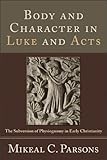Body and character in Luke and Acts : the subversion of physiognomy in early Christianity / Mikeal C. Parsons.
Material type: TextPublication details: Grand Rapids, Mich. : Baker Academic, c2006.Description: 191 p. ; 23 cmISBN:
TextPublication details: Grand Rapids, Mich. : Baker Academic, c2006.Description: 191 p. ; 23 cmISBN: - 080102885X (pbk.)
- 9780801028854
- Bible. Luke -- Criticism, interpretation, etc
- Biblija Novi zavjet Lukino evanđelje -- Kriticizam i tumačenje
- Bible. Acts -- Criticism, interpretation, etc
- Biblija Novi zavjet Djela apostolska -- Kriticizam i tumačenje
- Physiognomy -- Biblical teaching
- Fiziognomika -- Biblijski nauk
- Physiognomy -- Religious aspects -- Christianity -- History of doctrines -- Early church, ca. 30-600
- Fiziognomika -- Religijski aspekt -- Kršćanstvo
- 226.4/06 22
- BS2589 .P36 2006
| Item type | Current library | Call number | Status | Date due | Barcode |
|---|---|---|---|---|---|
 Books
Books
|
Biblijski institut - Amruševa | 226.4/06PARbo (Browse shelf(Opens below)) | Available | 6170506 |
Browsing Biblijski institut - Amruševa shelves Close shelf browser (Hides shelf browser)

|

|

|

|

|
No cover image available | No cover image available | ||
| 226.4/06NICpr2 Preaching the Gospel of Luke : | 226.4/06NICpr3 Preaching the Gospel of Luke : | 226.4/06NICpr4 Preaching the Gospel of Luke : | 226.4/06PARbo Body and character in Luke and Acts : the subversion of physiognomy in early Christianity / | 226.4/07PARlu Luke / | 226/.406TANna2 v.1 The narrative unity of Luke-Acts : | 226/.406TANna2 v.2 The narrative unity of Luke-Acts : |
Includes bibliographical references (p. 159-170) and indexes.
Soul and body react on each other: body and character in Greek and Roman literature --
The movement of the body is a voice of the soul: body and character in early Jewish and Christian literature --
Your eye is the lamp of your body: Luke and the body-soul relationship --
Ought not this daugher of Abraham be set free? Getting the story of the bent woman straight --
Short in stature, son of Abraham: the height of hospitality in the story of Zacchaeus --
His feet and ankles were made strong: signs of character in the man lame from birth --
What is to prevent me? Ambiguity, acceptance, and the Ethiopian eunuch.
In the ancient world, it was commonly believed that outward appearance provided clues to inner character. The "science" relating physical appearance to moral character is called physiognomy. Mikeal Parsons shows how a number of interesting episodes in Luke and Acts draw upon physiognomy only to subvert it. For example, short physical stature was an indicator of small-mindedness. After his encounter with Jesus, Zacchaeus is still short physically; however, his small-mindedness has been healed, and he repays fourfold those he has defrauded. Thus Luke ultimately denies that any direct line can be drawn between physical appearance and moral character.

There are no comments on this title.